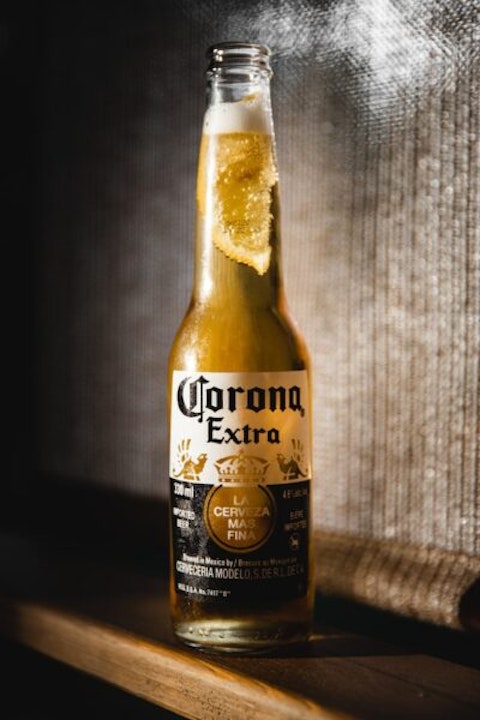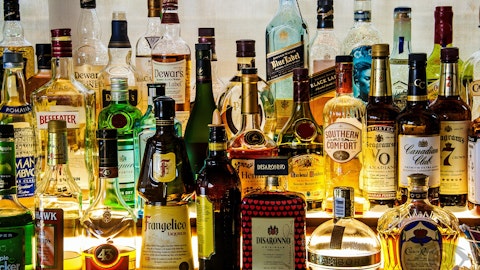Compañía Cervecerías Unidas S.A. (NYSE:CCU) Q4 2022 Earnings Call Transcript March 1, 2023
Operator: Ladies and gentlemen, thank you for standing by. Good day, and welcome to CCU’s Fourth Q2022 Earnings Conference Call on the 1 March 2023. Today’s conference call is being recorded. At this time, I would now like to turn the conference over to Claudio Heras, the Head of Investor Relations. Please go ahead, sir.
Claudio Las Heras: Welcome, everyone. Thank you for attending CCU’s Fourth Q2022 Conference Call. Today with me are Mr. Felipe Dubernet, Chief Financial Officer; and Mr. Carlos Anwandter, Financial Planning and Investor Relations Manager. You have received a copy of the company’s consolidated fourth Q2022 results. Felipe will now review our overall performance, and we will then move on to our Q&A session. Before we begin, please take note of our cautionary statement. The statements made in this call that relate to CCU’s future performance or financial results are forward-looking statements, which involve known and unknown risks and uncertainties that could cause actual performance or results to materially differ. These statements should be taken in conjunction with the additional information about risks and uncertainties set forth in CCU’s annual report in Form 20-F filed with the U.S. Securities and Exchange Commission and in the annual report submitted to the CMF and available on our website.
It is now my pleasure to introduce Felipe Dubernet.
Felipe Dubernet: Thank you, Claudio, and thank you, you all for joining us today. In 2022, we faced a particularly challenging year for the profitability of the business, especially in Chile. Consolidated EBITDA dropped 19.6%, while EBITDA margin deteriorated from 17.9% to 13.2%. Financial results were mainly affected by negative external effects coming from the depreciation of our main local currencies against the U.S. dollar and higher prices in raw materials, packaging and energy, impacting our costs. The latter was partially offset with prices and efficiencies. Net income contracted 14.7%. In spite of the deterioration of our results, I would like to comment on the actions that we took in 2022, which put us in a position to look for profitability improvement in 2023.

Photo by Jeff Vanderspank on Unsplash
First, we were able to preserve business scale as volumes decreased 1.1% despite a high comparison base from last year and a weaker consumption environment. Second, we overall kept market share in our core categories. Third, we strengthened our portfolio of brands by reaching historically — historical brand equity level in our main category in the region. And fourth, we implemented revenue management initiatives in all our geographies to mitigate cost pressure with prices in line with inflation in our main categories by the end of the year, especially in Chile. All of this will be enhanced this year by the implementation of HerCCUles 2023 a recovery profitability plan, which encompasses 6 pillars. Maintain our business scale. Second, strengthening revenue management efforts; enhance the CCU Transformation program to deliver efficiency gains in costs and expenses.
Focalize and optimize CapEx together with optimizing working capital. Focus on core brands and high-volume margin innovation. And continue investing in our brand equity. I would like to mention that by the end of the year, we started to see some positive trends from this, especially in Chile, reflected on prices, which expanded in line with inflation and efficiencies in costs and expenses. From a quarterly perspective, in Q4, 2022, we continue operating in a tough economic environment, which impacted consumption. Top-line decreased 6.6%, driven by 5.5% drop in volumes, however, 10% growth versus Q4, 2019, and a 1.1% decrease in average prices in Chilean pesos. EBITDA contracted 21% and EBITDA margin decreased from 18.9% to 16%. The latter mainly associated with the same negative external effect that impacted us during the year.
Net income fell 36.4% caused by a lower operational result as explained, and a greater loss in non-operating results, mainly driven by higher financial expenses due to a larger debt. In terms of our segment, in the Chile operating segment, top line grew 3.6% in Q4, 2022, due to a 12.4% growth in average prices, partially compensated by 7.8% lower volumes. However, with growth against Q4, 2019, we grew 12.7%, mostly due, of course, we had a very high comparison base in 2021. EBITDA decreased 24.4% and EBITDA margin decreased from 19.4 to 14.2. In International Business Operating segment, which includes Argentina, Bolivia, Paraguay and Uruguay, net sales dropped 27.6%, mainly as a result of a contraction of 26.7% average prices in CLP, although the increase in local currency in line with inflation, while volumes contracted 1.1%, the growth against Q4, 2019 was 4.7%.
EBITDA went down 19.7%, negatively impacted by the exchange rate translation effect in Argentina related with hyperinflation accounting. In the Wine Operating segment, revenues were up 3.2%, mainly explained by a 5.7% growth in average prices partially offset by a 2.4% contraction in volumes, 8.4% growth versus Q4, ’19. As a consequence, EBITDA improved 18.5%. Regarding our main joint ventures and associated business, in Colombia, where we produce and distribute beer and not with Postobón, top line growth, almost 20% in Chino driven by volumes and average prices. Thus, we continue expanding business scale during the year. In Argentina, our recently acquired water business, where we have a joint venture with Danone showed strong top line growth led by volumes and higher prices, allowing a recovery in financial results.
Both JVs represented CLP 7.4 million as of December 2020. Now I will be glad to answer any questions you may have.
See also 15 Countries with Highest Inflation Rates and 20 Most Important Companies in the World.
Q&A Session
Follow Clear Channel Communications Inc (NYSE:CCU)
Follow Clear Channel Communications Inc (NYSE:CCU)
Operator: Our first question comes from Mr. Felipe Ucros from Scotiabank. Please go ahead. Your line is open.
Felipe Ucros: Let me start with the normalization of trends. Last few quarters have seen a bit of a reversal of the incredible premiumization that you guys saw over the previous two years. I think locations and channels have also been normalizing. So that’s been a little bit of a headwind. Just wondering if you could give us an idea of how far you think you are from reaching a stable level on those metrics?
Felipe Dubernet : Thank you for your question. What I can say is that we have experienced throughout the year in 2022, especially from Q2, Q3 and now Q4;. If you compare Q4, against the two previous quarters, we saw a sequential improvement in our results. So — because, for example, in Q2, Q3, our margin contraction was, for example, a consolidated level 700 basis points, and especially in Chile was 1,000 basis points per contraction in margin in Q2 and Q3. So this was the bottom in terms of bad results. What I can say is that in Q4, the deterioration of the margin was half of what we experienced in Q2, Q3, and especially in Chile. So Chile has improved — is in the right trend to improve the margin. So as we said on previous calls, it takes time to recover the profitability.
But all the actions are in claims. So first, prices, as you saw, especially in Chile, we were able to catch-up inflation or mostly catch-up inflation towards the end of the year, so that’s good news. And on the other hand, we are a more favorable exchange rate in Chile so that certainly should impact our cost base. But nevertheless, I think the big risk is about the industry volumes. Why we are preserving or even growing market share the last finals — the last measure on market share at the end of the year and beginning of the year are very good for CCU, especially in Chile, in all the categories, be nonalcoholic and wine. However, we are seeing an industry deterioration. So at the end, we will see along the time a sequential improvement as we experienced in Q4, compared to Q3 in terms of our results.
By saying that, all — although this world is very volatile. Today, we have experienced, I don’t know, CLP 100 less exchange rates than Q3, for example. However, the scenario is volatile. By saying that, I could say, but all these structural actions are taken.
Felipe Ucros: Understood. Any details you can give us on premiumization and channels? How close are they to a normalized level?
Felipe Dubernet : All of these, of course, we reach not only a very high comparison volume as we discussed several times in 2021, especially because of the exceptional consumption growth that we experienced last year, but also a high premiunization in many categories, especially in alcoholic products. So today, we are experiencing a decrease in terms of premium mix, going the consumer more to the mainstream brands. However, I would like that is still much higher the premium mix than in 2019. So there is some sort of normalization or standardization of that, we have experienced. So this, of course, is also jeopardized a little bit the price efforts. However, we are confident that it would stabilize along the year at higher level than the one we had In terms of channel, I think you asked about channel. Still, the on-premise channel in Chile is less of what it was in 2019. So it has not fully recall. But I would say it has recovered, but not at the level of 2019. Okay?
Operator: Our next question comes from Mr. Lucas from JPMorgan. Please go ahead. Your line is open.





